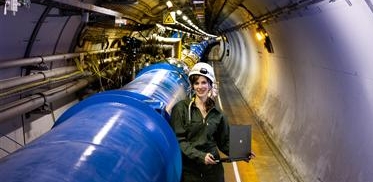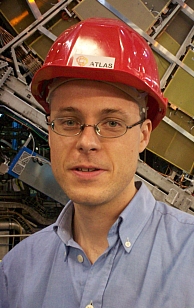First particles observed in Large Hadron Collider
Published: 26 August 2008
Glasgow scientists, working at CERN, have observed the first particles in the Large Hadron Collider during preliminary tests ahead of the switch-on next month.
Glasgow scientists, working at CERN, have observed the first particles in the Large Hadron Collider during preliminary tests ahead of the switch-on next month.
The LHC, based at the European particle facility CERN near Geneva, is due to fully switch on its proton beams on 10 September but the LHC's particle detectors have been recording hits from cosmic rays for several months and at 5pm on Friday 22 August 2008 LHCb*, one of the four LHC experiments, reconstructed in its Vertex Locator (VELO) the first particles from the LHC. It is the first time particle tracks have been reconstructed from a man-made event generated by the collider. 
The observation was made during a synchronisation test of the accelerator when the particles passed through a short section of the new 27km long LHC accelerator.
The LHC synchronisation test collided a beam of protons with a 28 tonne absorber 200m away from LHCb, producing a shower of particles. Some of these particles reached the LHCb experiment, where the tracks were observed by a small team of scientists. The observation was made with one quarter of the LHCb VELO detector operational on Friday 22 August. Given the success of this run, an additional sequence of beam collisions on the absorber were provided by the accelerator on Sunday morning and the full VELO detector was read out.
Professor Themis Bowcock (University of Liverpool), VELO Project Leader, said: “This achievement by the LHCb VELO – reconstructing the first tracks at the LHC - is a testament to the hard work and dedication of the team of scientists, who have worked on this detector for more than a decade.”
The VELO is a precise particle-tracking detector that surrounds the proton-proton collision point inside the LHCb experiment. At its heart are 84 half-moon shaped silicon sensors, each one connected to its electronics via a delicate system of more than 5000 bond wires. These sensors will be located very close to the colliding LHC beams, where they will play a crucial role in detecting b quarks, to help in understanding tiny but crucial differences in the behaviour of matter and antimatter. 
Dr Chris Parkes (University of Glasgow), UK VELO Project Leader and VELO software co-ordinator, said: “The particles were seen by the team of scientists within seconds, and from the very first collision! This bodes well for the future operation of the experiment to explore the differences in behaviour of matter and anti-matter. ”
Dr Eddy Jans (Nikhef), VELO commissioning coordinator, said: “We had been preparing all week for this first chance to see tracks. In order to see these particles we had to setup the electronics to take the data at just the right time – and we got it correct to within 25 billionths of a second.”
The 27km long LHC accelerator and its four large experiments at CERN, with over 5,000 collaborating scientists, are currently in their commissioning stages. This observation of first particles from the beam, comes several weeks ahead of when the first collisions between the two beams are expected. The first beams to circulate around the complete ring are expected for 10 September, when over 200 journalists are expected to attend at CERN.
Dr Eduardo Rodrigues, a research assistant in the Glasgow LHCb group, and the LHCb VELO data quality co-ordinator said: “I had worked on the real-time monitoring plots which allowed us to see the particles traversing the detector. I was overwhelmed when we saw the evidence of the particle tracks clearly appearing on the computer monitors in the control room”.
Marco Gersabeck, a PhD student at the University of Glasgow, said: “It's working! And it is providing me with the type of particle tracks that I will use to align its sensors to an accuracy of a few millionths of a metre.”
UK scientists from the Universities of Glasgow and Liverpool have a major involvement with the Vertex Locator. The individual modules were designed and assembled in the UK. The reconstruction software used to observe these tracks was written by UK scientists. Nikhef provided the mechanics, cooling and vacuum system. Other collaborators are EPFL Lausanne, CERN, Syracuse University, Moscow State University, University College Dublin.
Further information:
Martin Shannon - University of Glasgow Press Office
Tel: +44 (0) 141 330 8593
UK Science Contacts
Dr Chris Parkes, c.parkes@physics.gla.ac.uk – Lead LHCb VELO scientist at the University of Glasgow
Professor Themis Bowcock, tjvb@hep.ph.liv.ac.uk – Lead LHCb VELO scientist at the University of Liverpool
*LHCb - Large Hadron Collider beauty
The LHCb experiment will help us to understand why we live in a Universe that appears to be composed almost entirely of matter, but no antimatter.
It specialises in investigating the slight differences between matter and antimatter by studying a type of particle called the 'beauty quark', or 'b quark'.
Instead of surrounding the entire collision point with an enclosed detector, the LHCb experiment uses a series of sub-detectors to detect mainly forward particles. The first sub-detector is mounted close to the collision point, while the next ones stand one behind the other, over a length of 20 m.
An abundance of different types of quark will be created by the LHC before they decay quickly into other forms. To catch the b-quarks, LHCb has developed sophisticated movable tracking detectors close to the path of the beams circling in the LHC.
Like all the detector experiments at CERN a worldwide team of scientists are involved in the design and construction of LHCb. The experiment involves over 600 scientists from nearly 50 institutes and universities in 15 countries. UK collaborators make up around 20% of this.
The LHCb group at the University of Glasgow consists of: Dr Alison Bates, Dr Silvia Borghi, Mr Laurence Carson, Mr Fred Doherty, Dr Lars Eklund, Mr Marco Gersabeck, Dr Vava Gligorov, Ms Lena Haddad, Mr Franciole Marinho, Ms Fiona McEwan, Mr John J. Melone, Ms Michelle Nicol, Dr Chris Parkes, Dr Andrew Pickford, Mr. Barinjaka Rakotomiaramanana, Dr Eduardo Rodrigues, Dr Paul Soler, Dr Tomasz Szumlak.
The observation is reported on the Nature website: http://www.nature.com/news/2008/080825/full/news.2008.1061.html
First published: 26 August 2008
<< August

